
See also:
Click here for the GALLERY.
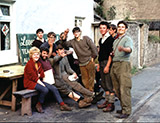
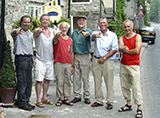
Cioch Club Days.
A personal recollection of climbing in the '60s at and around Stoney Middleton in the Peak District of Derbyshire. Cioch club memoirs, text and pictures.
Left, the way we were in the 1960s'. John (Ackers) Atkinson, Dave Nowill, ?, front row Sheila Stokes Brian (Tanky) Stokes, Geoff Birtles, Jim Ballard, Brian Starkey, behind?, Brian (The Nose) Moore.
Right, The way we are. L-R John (Ackers) Atkinson, Geoff Birtles, Gerry Langsley, Jack Street, Brian (Wattles) Starkey, Chris Jackson (me).
Click to enlarge.
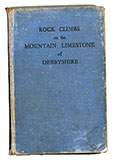
This is not intended to be a diary of Peak District climbing or even the Cioch club in the '60s, indeed, the photos are not even in chronological order but rather as I've come across them in old folders and other other unsuitable places.
However, to begin at the beginning, as someone famous once said. Climbing on the limestone outcrops of the Peak District began for most of us with the publication of Graham West’s little blue guide book ‘Rock Climbs on the Mountain Limestone of Derbyshire’, published in 1961, price 12 shillings and sixpence. In fact, this publication marked the beginning of my lifestyle much as it's continued to this day. My earliest recollection is os sitting in the Moon Inn at Stoney Middleton with Jack Street, Dave Nowill and John Atkinson listening to Little Eva singing Locomotion, which must put it at 1962. With these and other friends, we explored and climbed in the limestone dales of the Peak District, bivouacked under boulders, in caves or even bus shelters both summer and winter in order to be where we wanted to be. At times we got wet and we got cold, we also drank rather too much beer and did a lot of laughing. Those were the best and most precious of times. Climbing on limestone was almost unheard of in the early sixties, most climbers frequented the local gritstone escarpments or visited the volcanic rocks of Wales and the Lake district. Limestone was regarded as loose and dangerous and not 'proper' rock. Well, there's no smoke without fire and there certainly was a good deal of loose rock that required cleaning off. There are tales a many of early climbers taking long falls clutching a large piece of detached limestone. The main problem was protection. Wired nuts had not been invented though threaded engineering nuts were used and whereas gritstone routes in the sixties would generally follow crack lines that took various forms of primitive protection, limestone routes often had to rely on pegs (pitons) for protection. These were never easy to come by and climbers returning from the Alps would often recoup expenses by selling pegs bought there. Here we were restricted to ex-WD (War Department) pitons known as dubdees or the occasional poor quality and overpriced Stubai peg from the local outdoor shop. Many climbers resorted to making their own pegs and even now 50 years on the occasional one can still be found on old routes long after the commercial ones have rusted away.
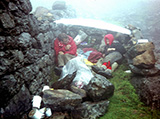
Bivouacking may be a romantic notion and sometimes it is a wonderful experience. The photo left shows the other side of the coin. This is in the old workings below Clogwyn d'ur Arddu, high on the slopes of Snowdon as evening deteriorated into a very wet and windy night. Experience now tells that a polythene sheet so arranged only gathers a large unstable puddle and that wrapping it around an wobbly piece of wall only makes the whole system collapse onto you in the middle of the night. Co-victims were Dave Nowill and Brian Starkey. Brian has recently surfaced living down in the soft white underbelly of England. Apparently not quite the slim line racing whippet he used to be but still cutting a dash on the golf course.

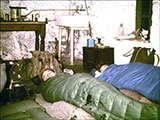
Things changed and the scene moved on; late 1963 we rented an upstairs room at the end of the cottages at Stoney Middleton from Eric, the cafe owner, our group of climbing friends became the Cioch Club and forsaking public transport and the hitch-hikers thumb many of us bought battered vans so that along with mates or girlfriends we could sleep in them and drive to North Wales, the Lake District or further afield. Eric had great plans for the cafe and was attempting to build up a B&B business. As such he had our end of his accommodation all replastered and redecorated. We redecorated our hut, i.e. Ackers, a plumber by trade fitted a sink into one corner and we built a double bunk system down one side of the room. The winter of '62/63 must have been cold as everything froze up but come the spring things began to thaw, including Acker's plumbing. In the middle of the night there was a great hissing and a jet of water spurted from under the sink and where was the stop tap? In Eric's cafe. He didn't live in at the time so the decision was made to break through the corner of our hut which was Eric's ceiling in the cafe in search of a stop tap. The water continued to pour through the floor as the lads hacked into Eric's newly decorated house. The stop tap was eventually found but next morning we had a lot of explaining to do such as why we didn't just grab a peg hammer and hammer the offending pipe flat.
An Ackers shots taken in the Cioch Club hut. Left to right Jack Street, Jim Ballard, late Colin (Domehead) Crooks, ?, Dave (Fidel) Turton, Dave Nowill, ?, Chris Jackson (me).
From about 1963 to 1969 Lover's Leap Cafe at Stoney Middleton in the Peak District ('Stoney Cafe or Eric's) was a social centre and meeting place for many climbers in the Peak District of Derbyshire. Saturday evenings in the Grouse or The Moon Inn were the places to be and were packed with climbers from far and afield. Darts was an essential skill and by the end of the evening the air was so thick with cigarette smoke that that you could cut it with a knife. Many wanted to sleep in the Cioch Club hut as it was known and we attempted to charge a pittance for the privelege.
The cafe was accidentally modified in 1964 when a lorry took out the front so that throughout a cold winter most of the building was supported on props and screened by tarpaulins.
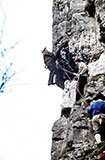

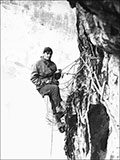
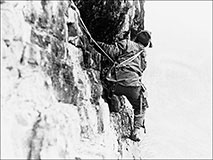
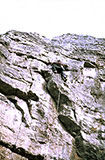
Left, an early ascent (attempt?) in 1963 on a route called Little Capucin at Stoney Middleton. Originally graded A1 (10-15 pitons) it was soon reduced to Hard VS and 1 piton, now free of course. Here I am standing in a sling attached to a piton, belaying is John Atkinson. I'm not sure who is in the corner, possible Dave Nowill. Pic.2 is a young looking me 1964 possibly on the Central Buttress Water cum Jolly. Note standard '60s climbing gear. The next two are of me on Central Buttress WCJ, boots, piton hammer, moleskin breeches, cambric anorak, classic belay with hawser laid rope and lots of rusty old home-made pitons. Photos John Atkinson.
It may seem like we all just dossed around, getting drunk on a saturday night and generally having a good time but we did do a fair amount of climbing as well. Early '60s Graham West's little guide book was all we had and the fact that it was full of mistakes, duplications, unfindable routes and misgrading was all part of the great mystery of limestone. For instance, Froth and Sin Exceptionally severe now VS, Valkyrie a 200 foot monster - lost, possibly a duplication of Frisco Bay/Golden Gate, Handy Groove 70 foot Severe - missing and it certainly wasn't the first pitch to what is now Memnon. The list goes on.
There was little pressure to climb new routes in the early '60s but gradually all the major lines at Stoney and beyond were ticked off and many of the aid points removed from previous more nervous ascents. Pendulum, the major break across Garage Buttress was not tried until 1963 when Brian Moore and Pete Fieldsend tried an aided ascent ant took a lot of air time. Goodness knows what they were knocking into that wide crack. Soon after, Jack Street and I made a free ascent finding it no more that HVS for a couple of moves. Girdles were popular in those days and Chee Tor girdle soon fell to myself, Brian (Wattles) Starkey and John Atkinson and with John Atkinson, Debauchery on high Tor, a diagonal line across the main face. Jasper was climbed with 3 points of aid in 1963 by Jack Street and Geoff Birtles, lower picture, not freed until 1975 by Tom Proctor. Ivy was removed, blocks prized off and gradually the crags lost their mystery and their age of innocence. Alcassan was climbed in bits by various members of the Cioch, perhaps the most outrageous bit was Bob Dearman's pegging of The Flakes in 1964, carrying enough pegs and artificial gear for an attempt on the Cima Ovest. A bit disgusted, I freed The Flakes and then with Geoff Birtles linked the whole traverse together with just a couple of pegs for handholds.
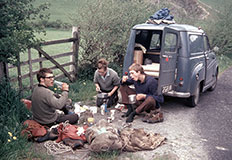
Jack Street was the first amongst us to get transport, thus achieving pop-idol status. Traffic was almost fun in those days and it was possible to stop at the side of the road without being accused of being new age travellers or being choked by exhaust fumes. Left is somewhere on the way back from a climbing weekend in North wales, possibly just off the A5 on the way to Ruthin. Left to right Dave Nowill, Carol Mk1 and Jack
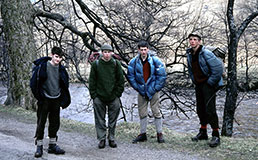
Left, the traditional Easter climbing trip the the Ben (Ben Nevis). As usual it rained almost continuously for 4 days. We stayed in Cameron’s barn in Glen Nevis. From the left is Captain Mick, John (Ackers) Atkinson, Colin (Domehead) Crooks and Jack Street. Cameron’s barn was a bit of an eye-opener for a young lad like me. The first hurdle was the large angry turkey, previously goaded into a frenzy by the RAF mountain rescue lads and which now guarded the entrance. Sleeping accommodation was upstairs on a floor of rotting timber. We shared the barn with climbers from the Creag Dhu, a Glasgow based climbing club with a fearsome reputation as hard men of mountain and bar, and we found ourselves a corner as far away from them as possible. Predictably, they all turned up well after midnight, were drunk, made a lot of noise and muttered about some English b****** f****** climbers in the corner. Later, unable to find the light switch they stacked some old boxes up to smash the bulb which happened to be above our heads. Showered in glass and a tumbling climber we uttered not a word. We were just too good mannered (and frightened). Next day someone covered one of the holes in the boards with newspaper and straw. When Cameron came to get his money he fell through, smacking his chin on the floor. Minutes later we were all out on the road in the rain.
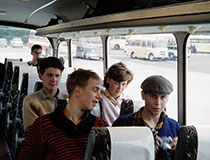
Above we are on a bus heading for the Lake District, probably 1963. This must pre-date any of us having transport. Back row we have Bob Roe and Marilyn Jackson, front row Jack Street and John Atkinson.

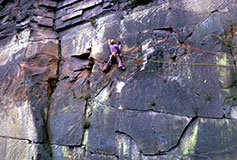
Exploring new crags and climbing new routes continually drew us into doing exciting things. Top left was taken on a sea cliff near Abersoch in North Wales that we called Cilan Head though this was not its proper name. The top of the cliff was particularly dangerous as the grass gradually steepened into vertical and then overhanging rock. There was no easy access and the only way in was by abseil for which belays were bordering on the dubious. In those days (mid 60s) we still climbed on hawser laid ropes and as we made the long free abseil to the platform below the rope made us spin so badly that we were almost throwing up by the time we reached the bottom. The original plan was to use prussick loops to climb out on the rope after exploration but as no one now fancied this and we all ended up swimming across a deep zawn to escape. Attempts to haul the dry clothes across on a rope failed miserably as the zawn was more than half the length of the rope.
In 1971 along with Bob Conway, Tom Proctor and Bob Nunns we climbed several new routes in this rather obscure quarry below Stanton Moor, lower left. The rock was rather soft and required a bit of care in places. Despite our aspirations the quarry never quite caught on and it's rather gone back to nature - perhaps for the best. Right, first ascent of the traverse, me in loons. Recently it was occupied by protesters against the restarting of quarrying in that area. Quite right too, the area is far too beautiful to start all that again.
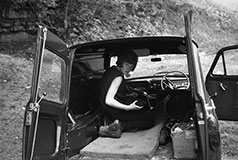
I’m starting to dig into a pile of dusty old negatives. So many gaps and I’m sure I used my camera fairly consistently throughout the sixties. I suspect that several house changes over the years have done their worst. In September 1964 I met Dot Chadwick who became my girlfriend for the next 15 months or so. She was a trainee teacher at Thornbridge Hall near Great Longstone in the Peak District and along with other climbers such as Jim Street and Ian Conway and their girlfriends we all became part of the crowd, tripping to Wales and The Lakes for climbing, drinking a bit too much and generally having a good time. Despite this I only seem to be able to trace two photos of her, one is out of focus, this is the other - Dot in the back of my Ford Anglia van. She was my first real girlfriend and I suppose that I wasn't really ready for a long term relationship. I was planning on going on expeditions and I didn't feel that I had my life planned out. Still, that night she told me that she'd met someone else I guess I'll never forget. The first cut is the deepest. Never take someone for granted is the lesson, we all learn I suppose. I often wonder what became of her and if she is still in the land of the living. I think that she broke my heart. Even now, happily married to Sue, if I ever find myself walking in that neck of the woods there always remains a slight feeling of sadness.
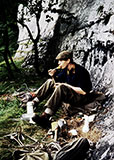
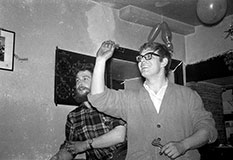
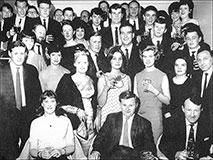 <<Click
<<Click
Bivouacking was a way of life between 1962 and 1964 before we had transport that we could sleep in. Left is John Atkinson at breakfast under a piece of overhanging rock known as The Cornice in Water Cum Jolly. The only route on there in 1963 was Nemesis graded Extremely Severe and A3 - top stuff. As I recall we had several epic attempts before actually getting up it. Note mashing can, primus, Stubai Berghammer and a pile of steel karabiners and pegs. There were few alloy karabiners in the early '60s apart from the Pierre Allain, a French krab that we couldn't afford even when it appeared in the shops. When climbing aid routes like Nemesis the weight of the steel karabiners and pegs was enough to give an aching shoulder all the following week. Though perhaps not quite the same line, the overhang has now been climbed without any aid from pitons. Damn!
L-R bivouacking in Water-cum-Jolly, Dave Nowill and John Atkinson in The Anglers Rest in Water cum Jolly. North Staffs Mountaineering club dinner.
A picture has recently been passed to me by the late Derek Walker and it shows our presence at a North Staffs Mountaineering Club dinner, probably 1965 or 66, note the suits that were normal attire for do's such as this. I think that it may have originated from Derek Walker who was a friend of Don Whillans. Its a grubby photo, being a copy of a copy of a print. Front right is the famous and late Don Whillans, his wife Audry is front left. Back right are Jack Street, Geoff Birtles and myself looking as if I am about to fall asleep. Centre back is Colin Foord. I am reliably informed that Al Evans was lying on the floor behind the group, clutching a bottle. Anyone recognise anybody else? Click to enlarge.

Above , a sensitive shot of Dave Nowill by John Atkinson, Dave was one of the founder members; sadly missed since committing suicide back in the '70s
In 1967 I went on expedition to Patagonia, but by then the scene was changing. The grouse Inn closed, many of the regular climbers were finishing college and moving away to find jobs, or getting married and unable to spend the same amount of time climbing. New climber arrived, performing at a high level that had been honed by difficult problems on the nearby gritstone. Tom Proctor, Gabe Regan, Steve Bancroft, Paul Mitchell, Gerry Moffat and many other excellent climbers were now arriving to take control.
Occasionally, I find myself wandering along those familiar path below the crags at Stoney Middleton. It's out of fashion now, the track is greening and the ivy gradually regaining its lost territory. Maybe it's the time of year or the smell of the fallen leaves but suddenly there's a lump in my throat and I'm whirled back all those years to 1962 when with Jack Street and Dave Nowill I first began to know these rocks that in so many strange ways have shaped my life. My Ford Anglia van is parked on The Promenade, young faces, voices in the trees, Brian Moore, Jim Street, Dot Chadwick, John Atkinson, Ian Conway and Wendy, Jack and Dave. Ghostly, some long gone. The best of times, times that will never come again.
Click here for the GALLERY.
Peak District, Climbing, Cioch Club
Chris Jackson e-mail me